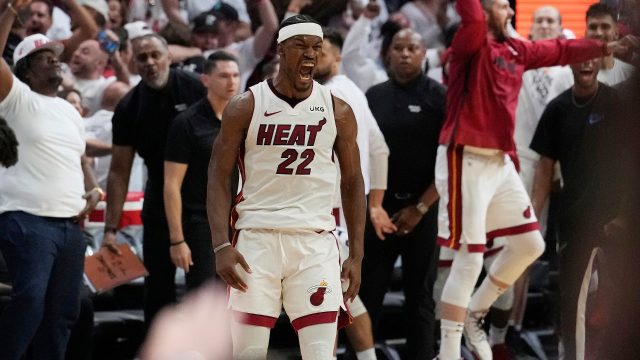Nostalgia is one hell of a drug, the saying goes.
Get ready to be breathing in the good stuff over the next couple of weeks as the second round of the NBA Playoffs tip off featuring the most nostalgia-driven 1990s matchup possible: a series pitting the New York Knicks against the Miami Heat.
Knicks-Heat was a big enough deal in the decade otherwise ruled by Michael Jordan that there’s an entire Wikipedia page devoted to it.
Even those who might not have first-hand memories of pairings that dominated the non-Jordan NBA news cycle for four consecutive post-season seasons from 1997-2000 — with each series going the maximum number of games — are likely familiar with some of the moments that have stood the test of time.
Like, for example, the Jeff Van Gundy GIF, featuring the then-Knicks head coach and current ESPN analyst getting dragged across the floor after attaching himself to Heat centre Alonzo Mourning’s right leg as part of a fracas that had broken out at the end of Game 4.
The background: It was the second consecutive playoff meeting between the two Eastern Conference rivals. The season before, in 1997, their series was effectively decided by another moment of on-court madness, when in the final moments of Game 5 of the second round, Knicks reserve guard Charlie Ward was overzealous in his box-out of Miami power forward P.J. Brown, the smaller Ward using his butt to shove the six-foot-11 Brown out of bounds – a little much in a game that was already decided. At that point, Brown reached over, grabbed Ward by the waist, lifted him up and drop the New York guard on his head.
“I don’t know what began this struggle,” said Verne Lundquist, who was calling the game on TNT. “But I did see P.J. Brown pick Ward up and heave him upside down.”
In the melee that followed, four Knicks starters, who were already pulled for the night in what was a blowout loss, came off the bench — the ultimate no-no in the NBA — to protect their teammate, and were suspended by commissioner David Stern, along with Ward. Only Brown was suspended for Miami. In the interest of fairness, New York’s suspensions were split, with three Knicks sitting out Game 6 and two sidelined for Game 7.
The Heat took advantage of the short-handed Knicks and won both games to come back and win the series after having been down 3-1.
In 1998, with tempers flaring again — this time it was burly Heat centre Alonzo Mourning getting into a scuffle with almost-as-burly Knicks forward Larry Johnson, a feud dating back to their days as teammates in Charlotte.
Desperate to avoid a repeat of the suspensions from the year before, when Johnson and Mourning began to tangle, the diminutive Van Gundy – all five-foot-nine and 160 pounds of him — decided it was him, rather than his players, who should try to de-escalate things. He sprinted onto the floor and grabbed at the six-foot-10, 260-pound Mourning, only to lose his balance and slide down the Heat’s centre’s body until the Knicks head coach was on the floor, holding onto Mourning’s considerable calf, refusing to let go with chaos all around.
A meme was born.
“When Jeff came out to protect his players, I admired that. At that time,” Mourning said years later, in an interview with Vince Carter. “[But] he felt like a piece of gum on my shoe, but I was trying to shake him off. He was wrapped around [my leg] and holding on for dear life.”
Despite 11 years coaching the Knicks and the Houston Rockets, a .575 winning percentage, a trip to the 1999 NBA Finals as an eighth seed and a long career as one of basketball’s premier broadcasters, being dragged around by Mourning is one of Van Gundy’s signature moments.
“Like a little muskrat,” was Van Gundy’s description.
In an exquisite bit of coincidence when the fifth-seeded Knicks host the eighth-seeded Heat at Madison Square Garden on Sunday afternoon, it will be 25 years to the day since that particular instalment of Knicks-Heat history entered the public consciousness, never to leave it.
Of course, everything that’s old isn’t quite new again.
Like the sport itself. Everything the NBA is now – wide open, free flowing, and high scoring. These days physical contact is more often an accidental by-product rather than seemingly the entire point. In that sense, it’s the opposite of what the NBA was at the time.
“Like watching cars getting crushed at the junkyard,” was how then-New York Times NBA columnist Mike Wise described the aesthetic.
It’s funny what people get nostalgic for.
Consider: over 24 games (two of the series were best-of-five match-ups the NBA used to have in the first round) there was only one in which even one team topped the 100-point mark — Game 7 in 1997, when Miami won 101-90. In contrast there were four games where neither team topped 80 points, the, uh, low point coming in Game 6 of the 2000 conference semifinals where the Knicks scratched out a 72-70 win in which the two teams combined to shoot 35.8 per cent from the field and 25 per cent from three.
This time around in their respective opening-round series wins — the fifth-seeded Knicks advancing in five games over No. 4 seed Cleveland and the Heat emerging from the play-in tournament to upset the No. 1 seed Milwaukee Bucks in five games — the Knicks are averaging 99.4 points per game, which is 13th out of 16 playoff teams, while the Heat lead the playoffs with 124 points a game.
I’m going not so far out on a limb to say that there won’t be a game in which both teams score less than 90 points. I’ll wager there won’t be a game in which even one team fails to score 80 points.
There’s an argument that the grinding metal that was the Knicks-Heat rivalry of the 1990s was responsible for the way the game is played today.
In the 1990s, any team with championship aspirations had to go through Jordan and the Chicago Bulls. Pat Riley, as head coach of the Knicks from 1991-92 to 1994-95, built his team with that in mind. The goal was to make Jordan pay a steep price to attack the rim. If long, sleek, and fast is the NBA prototype of today, slow, bruising, and brutal was en vogue then. This was an era where Charles Oakley was only the Knicks’ second most physically imposing forward, behind Anthony Mason. Biceps were everywhere.
When Riley left the Knicks for the Heat on the eve of the 1995-96 season — a defection portrayed in some corners as a betrayal — it not only lit a fuse under the rivalry between the two franchises, but it also saw the Heat transformed into a warm-weather version of the Knicks, complete with rosters deep in physically tough, competitive players who felt perfectly comfortable putting their opponents on the floor with force.
The lanes were clogged, offensive players were man-handled, on or off the ball, and going to the rim was like stepping out on tightrope in a hurricane: good luck.
It all resulted in an athletic opera thick on back stories, intrigue, and violence, all serving as worthy content when Jordan and the Bulls weren’t playing.
Those days are long gone. Rules have been changed to favour offence and emphasize shooting, pace and skill. And if the fire-breathing hate that was part of the landscape then — “I hate them with all the hate that you can hate with. Can you hate more than that? If you can, I hate them more than that,” was how Heat guard Tim Hardaway once described his feelings for the Knicks” — isn’t as common a feature of the current game, the level of basketball is probably higher. Scoring is up, and speed rules, even in a series between the Heat and the Knicks.
It’s a rivalry that can’t be what it once was, on the floor at least, which is maybe for the best.
We will always have the memes, though — memes and memories.
Don’t be afraid to inhale.





























